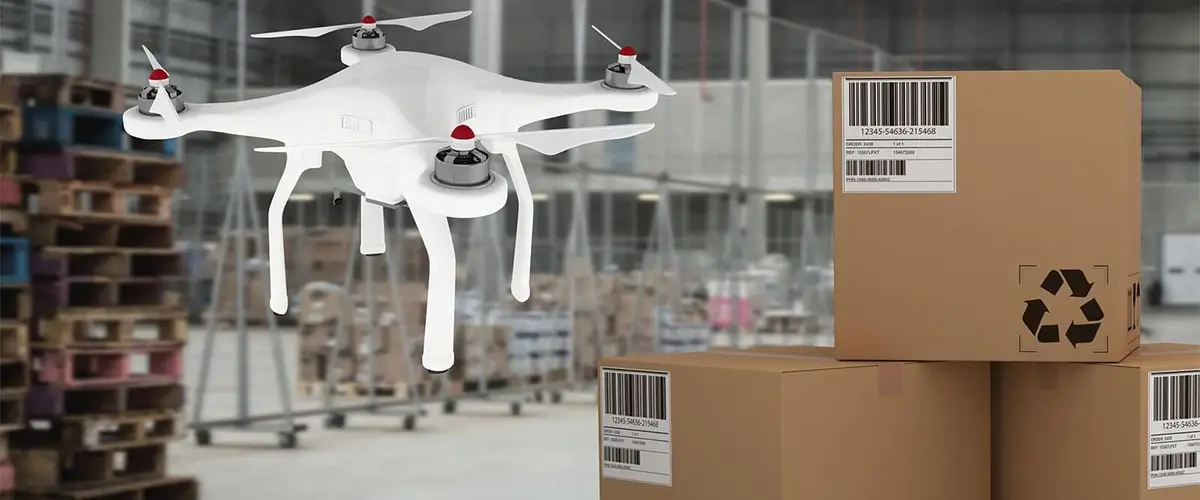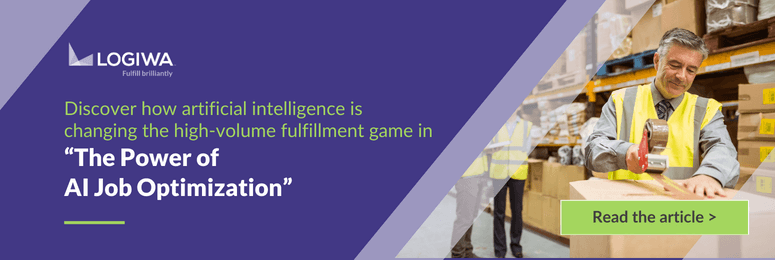Key Takeaways:
- Drones are projected to generate $82 billion in economic growth by 2025, signaling a significant shift in the logistics industry.
- The integration of drones can make the ecommerce industry more environmentally friendly, reducing carbon emissions associated with traditional delivery methods.
- Customer expectations are set to rise, with drone delivery potentially making same-day or even same-hour deliveries the new norm.
- Warehouses and 3PLs will undergo operational changes, adapting to the speed and efficiency that drone deliveries demand.
- Drone delivery will not only impact the initial shipment but could also revolutionize the reverse supply chain, streamlining returns and reducing associated costs.
12 Ways Drone Delivery Will Transform Logistics
Unmanned aerial vehicles, more popularly known as drones, are expected to generate $82 billion in economic growth by 2025 along with 100,000 jobs. Despite recent regulations, the Federal Aviation Administration (FAA) has already issued hundreds of waivers to companies interested in commercial drone use. While it’s easy to see how drones will impact a number of industries, they will have the greatest impact on supply chain and logistics.
If the idea of drone delivery makes you excited, we are here to help you breathe through it. By the end of this article, you’ll be able to have an understanding of:
Content:
- Retailers Will Begin to Supplement Carrier Relationships With In-House Capabilities
- The Ecommerce Industry Will Be More Environmentally Friendly
- Customer Expectations Will Soar and Same-Day Deliveries Will Become the New Normal
- Warehouses and 3PLs Will Need to Speed Up Their Operations
- The Layout of Warehouses Distribution Centers Will Dramatically Change
- Drones Will Increase Efficiency Within Warehouses
- Brick-and-Mortar Stores Will Face a Mortal Threat
- Retailers Will Have To Contend With a Whole New Range of Regulations
- Retailers Will Need to Account For Theft, Damage, and Cybercrime
- Drone Deliveries Will Start a Bigger Conversation About Privacy
- Retailers’ Reverse Supply Chain Management Will Transform
- Drone Delivery Costs Will Revolutionize Last Mile Delivery
Here, we take a look at 12 ways we can expect the logistics industry to be transformed with warehouse robotics in supply chain.
Retailers Will Begin to Supplement Carrier Relationships With In-House Capabilities
In 2013, Jeff Bezos unveiled Amazon’s drone delivery ambitions on “60 Minutes.” Rather than completely eliminating third-party contracts, the company intends to supplement its existing delivery options with drone delivery capabilities. It’s already started expanding control of its logistics by investing in its own fleet of trucks, rolling out a crowdsourced delivery service with a network of third-party drivers, and purchasing its own Amazon-branded Boeing 767.
In short, Amazon wants to limit its reliance on external companies and even challenges like congested roads. According to industry experts, we’re closer to a world with drone delivery than we are to a world with self-driving cars. In fact, according to some, there would already be package delivery by drones right to U.S. doorsteps if it weren’t for regulatory hurdles.
Once these regulatory hurdles are overcome, retailers already leveraging automation within their warehouses will extend automation outside of their warehouses. Automated storage and retrieval systems, conveyor belts, and other warehouse automation tools will be coupled with an automated inbound outbound logistics system that delivers products to customers by drone.
The Ecommerce Industry Will Be More Environmentally Friendly
In 2016, transportation beat power plants for the title of top carbon dioxide producer in the United States. Notably, there’s been a significant increase in the volume of last mile deliveries, which is the trip between the warehouse or distribution center and the recipient. In the past, the majority of last mile deliveries were bulk shipments to stores in concentrated areas. As a result, carriers could fulfill these deliveries with large trucks. Today, individual deliveries reign supreme. In 2020, global parcel volumes are expected to exceed the 100 billion mark.
A 2018 study found that electric drone delivery was more efficient than trucks, vans, passenger cars, and gasoline drones. And, while the researchers conceded that the environmental impact of electric drone delivery would go up once recharging costs were factored in, they would still be more environmentally friendly than one-off deliveries using other methods.
Electric drones and other warehouse robotics in supply chain are part of Amazon’s plan to make all Amazon shipments net zero carbon, a goal it intends to have 50% complete by 2030.
Customer Expectations Will Soar and Same-Day Deliveries Will Become the New Normal
During the 2019 Re:Mars conference in Las Vegas, Amazon showcased a new drone it planned to use as part of its Prime Air service. The device, which can carry packages weighing 5 pounds or less for 15 miles, is part of the company’s anticipated rollout of drones in the near future. While Amazon didn’t provide an exact date, the company does have a permit from the FAA to “establish a package delivery operation in the United States”.
Once Amazon establishes a widespread drone delivery program, it will once again raise the bar for other retailers who have already bemoaned the “Amazon effect,” which has raised customer expectations and turned things like free shipping and two-day delivery into the standard as opposed to a luxury.
In addition, drone delivery will also revolutionize customer expectations around what can be delivered. Everything from medicine to coffee to blood is already being transported by drones in locations around the world.
Ready to upgrade your cost-saving strategy with an integrated WMS? Schedule a demo today to see how Logiwa can bring the cheapest shipping options to your business.
Warehouses and 3PLs Will Need to Speed Up Their Operations
Warehouse managers are familiar with supply chain time crunches and the importance of efficient processes like directed putaway, picking, and packing. The longer it takes to process an inbound shipment, the longer it takes for products to be entered into inventory and the fewer items are available for purchase and picking.
These demands on warehouses will only increase once drone delivery becomes the standard delivery method and as timelines move from same-day to same-hour. Warehouse owners will need to optimize and streamline their operations through rigorous processes, automated tools, and more sophisticated 3PL warehouse management systems.
For instance, during the putaway stage warehouses may need to embrace cross-docking operations. During the picking stage, advanced pick processes like wave picking or batch picking may be called for. And the packing process may need to be sped up with taping machines, 3D packing screens to help quickly fit packages into the right sized boxes, shipping label printers, and more. Using the right WMS, all of these processes can be centrally managed and even automated.
The Layout of Warehouses Distribution Centers Centers Will Dramatically Change
Delivery via drone will impact more than the transportation of goods. It will also impact how warehouses and distribution centers are designed and laid out. Today’s warehouses have large docks that determine how quickly goods are entered into inventory or shipped out to customers. Excellent dock management ensures incoming shipments, outgoing shipments, and labor scheduling are properly coordinated to avoid long wait times.
The obvious change will be the size of docks. Warehouse managers will no longer need extremely large docks to accommodate fleets of trucks. But more interestingly, drones may completely transform the concept of warehouses and distribution centers.
How? Take the case of Amazon’s awarded patent for an airborne fulfillment center utilizing unmanned aerial vehicles for item delivery, also known as a “floating warehouse”. In short, a helium-filled blimp would drift above airline traffic, storing inventory in they sky and air dropping lightweight packages using drones. While this may be a while away, it does demonstrate how drone technology could reinvent the entire warehouse industry.
Brick-and-Mortar Stores Will Face a Mortal Threat
Presently, the biggest advantage brick-and-mortar stores have over online stores is immediacy. A customer can walk into a store and walk out with what they want within an hour. They also have the ability to try on items, feel materials, and manipulate objects to inspect them from different angles. For all of its convenience, the best online retailers can offer is next-day shipping – and even that comes with a steep price tag.
The use of a drone delivery system could shrink delivery times from a matter of days to a matter of minutes. This has huge ramifications on the physical shopping experience since customers could have products delivered to them in less time than it takes to drive to the mall. The final frontier will be the unique customers experience retailers can offer shoppers.
Retailers Will Have To Contend With a Whole New Range of Regulations
The Federal Aviation Administration (FAA) has created rules around what drone owners can and can’t do. For recreational users, regulations like registering their drones and flying below a certain altitude are not a big deal.
For companies interested in commercial drone usage like drone delivery, several rules stand in their way. Most notably, the “line of sight” rule which requires drone owners to keep their drones within eye shot at all times. For other limitations, businesses can apply for waivers to circumvent the regulations, including:
- Flying a drone from a moving aircraft or a vehicle in a populated area
- Flying at night
- Flying multiple drones with only one remote pilot
- Flying over people
- Flying over 400 feet above ground level
- Flying over 100 miles per hour groundspeed
- Flying with less than 3 statute miles of visibility
Drones Will Increase Efficiency Within Warehouses
Beyond delivery, drones will change how warehouses approach key operations. For instance, drones can be used to circle the perimeter of a warehouse and conduct safety inspections to ensure a better workplace. They can support the inspection, preventative maintenance, and repair of complex machinery within a manufacturing plant.
Drones could also be used to speed up the pick and putaway processes, which are expensive, labor-intensive activities. Lightweight drones could be used as an alternative to conveyor belts or forklifts for retrieving and putting away orders. Warehouse workers could be re-trained to become warehouse drone operators.
Retailers Will Need to Account For Theft, Damage, and Cybercrime
In theory, drone delivery offers speedier delivery, but that doesn’t mean consumers are entirely comfortable with the technology. 33% of consumers believe drone shipping will make their shopping faster and 21% believe it will be comparatively cheaper. However, there are some concerns about possible theft or damage. 20% of consumers in one survey reported concern about damage when products are delivered via drone. Another 19% are worried about their drones being stolen or hacked.
Yes, that’s right. Drones have become a headache for cybersecurity professionals and law enforcement officials. A drone can cost anywhere from $30 to $10,000 and be used for illicit purposes like surveillance, data theft, or network disruption.
In addition, damage to consumers’ deliveries won’t be the only damage retailers will have to think about. Damage to property in general (e.g., if a drone crashes into someone’s house or car) will be another element retailers will have to manage. Not surprisingly, the insurance industry is stepping up with coverage options to prepare for widespread commercial drone delivery.
Drone Deliveries Will Start a Bigger Conversation About Privacy
If a drone flies above your house while en route to deliver a package to your neighbor, is that trespassing? What will the law say about drones taking pictures of people and buildings on the ground? Can a drone delivering a package snap a photo of the customer’s shabby roof while its there and use that data to suggest roof repair services?
Drone delivery will open a legal can of worms with tough questions companies and regulators will need to answer.
Retailers’ Reverse Supply Chain Management Will Transform
The cost of return deliveries, worldwide, is $642 billion USD. The reverse supply chain is an incredibly costly process and in need of innovation. While conversations about commercial drone delivery tend to focus on the initial shipment, widespread usage of drones could also transform the reverse supply chain.
The reverse supply chain is unpredictable, partly because goods are returned to retailers in a range of conditions. Returns throw off inventory counts and retailers grapple with overstock. Then, they lead to bottlenecks in cases where the retailer has to decide between putting the item back in stock or sending it back to the manufacturer.
Drone deliveries could potentially streamline this process by allowing individual products to go to the correct location the first time, whether it’s for repairs or resale. It would also limit the amount of fuel used to transport goods, creating a more sustainable supply chain.
Drone Delivery Costs Will Revolutionize Last Mile Delivery
According to Deutsche Bank, using drones and robots for delivery automation could present significant cost savings, with 80% of those cost savings showing up in the last mile. Consider the cost of a shoebox delivery across the last mile: a shoebox delivery with a premium carrier like FedEx UPS can cost $6 to $6.50 while USPS can cost $2. A drone delivery would cost less than $0.05 per mile.
Drone deliveries would introduce shipping that is both cheap and fast, two things that have been considered mutually exclusive in the past.
Drove Delivery Will Have a Transformative Effect On The Entire Supply Chain
Drone delivery will revolutionize how retailers fulfill orders, warehouses manage their operations, manufacturers handle inspections, and more. While we are still a long way from a widespread drone shipping company, the number of waivers issued by the FAA suggests companies are working hard to make it a reality sooner rather than later.
H2: Navigating the Drone Logistics Revolution with Logiwa WMS
The realm of drone logistics is poised to redefine the very fabric of supply chain management. As drones promise faster, more efficient, and environmentally-friendly delivery solutions, businesses must adapt to harness their full potential. For those looking to stay ahead in this evolving landscape, integrating a system like Logiwa WMS can be the key to optimizing operations in a drone-driven world. Dive into Logiwa’s offerings and ensure your business is ready for the future of logistics.
FAQs: Drone Logistics
Q: What is the potential economic impact of drone logistics on the logistics sector?
A: Drone logistics is projected to generate a staggering $82 billion in economic growth by 2025, indicating a transformative shift in the logistics industry.
Q: How can drone logistics benefit the environment, especially in the ecommerce sector?
A: Drone logistics can make ecommerce deliveries more environmentally friendly by significantly reducing carbon emissions compared to traditional delivery methods.
Q: With the rise of drone logistics, what changes in customer expectations can businesses anticipate?
A: As drone logistics becomes more prevalent, customers will likely expect faster delivery times, with same-day or even same-hour deliveries becoming the new standard.
Q: How will warehouses and 3PLs adapt to the integration of drone logistics?
A: Warehouses and 3PLs will undergo operational changes to accommodate the speed and efficiency that drone deliveries demand, ensuring they can support and benefit from this new delivery method.
Q: How can Logiwa WMS assist businesses in adapting to the drone logistics revolution?
A: Logiwa WMS offers advanced tools and integrations that can help businesses optimize their operations, ensuring they are well-prepared and efficient in a drone-driven logistics landscape.
The Leading Supply Chain Management Software for “New Age” B2C/B2B Fulfillment Businesses
Warehouse Management
Modern WMS cloud fulfillment powers a modern experience
Inventory Management
Improve your inventory across your supply chain.






